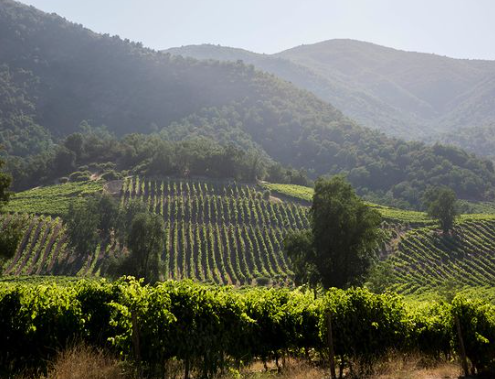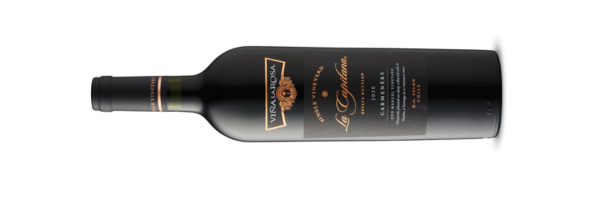Carménère’s origins are the flat, Atlantic vineyards that surround the Gironde Estuary, better known as Bordeaux’s Medoc region. It was there, in the early 18th Century, that the grape established itself as one of the finest in all of France and, therefore, in the world. The infamous phylloxera louse that laid waste to vineyards across Europe in the mid 19th Century forced Bordeaux vignerons to replant their land. When they did, they favoured Cabernet Sauvignon and Merlot — higher yielding, easier-to-grow varieties. Thus began the slow, permanent decline of French Carménère, a grape that now totals less than 70 hectares under vine.
Thankfully for Carménère, it found a promising new home in Chile’s Central Valley. The grape was brought to the South American country in the 1800s. However, until the 1990s, half of the Carménère planted was thought to be Merlot. The two look nearly identical in the vineyard and possess enough similarities in the glass for the mistaken identity to continue for almost 150 years. Carménère is now the 5th most planted grape in Chile and performs best in the Colchagua and Cachapoal Valleys.
The grape is late ripening, requiring a long growing season to achieve full maturity. This is one of the reasons it fell out of favour with the Bordelais. Their moderate, Maritime climate didn’t always provide adequate growing conditions for Carménère to show its best. But the Central Valley’s warm, sunny climes were ideally suited to fully ripen the grape and fully realize its potential. It is naturally low-yielding, meaning each vine produces less fruit with smaller berries, resulting in deeply-coloured, concentrated wines.
Carménère has the structure of Cabernet, with the allure and ease of Merlot. Generally speaking, it makes wines with bright red fruits alongside a subtle savoury character. It possesses a high amount of pyrazines, an aroma compound that imparts notes of bell pepper and eucalyptus. When grown properly, and on good sites, those notes linger in the background, adding intrigue and complexity to the wine’s rich, warm fruit, full body and silky tannins. Think fuller, richer, riper Cabernet Franc.
Cachapoal is warm and fertile, so care needs to be taken to force Carménère to work hard in the vineyard in order to produce high-quality grapes and wine. And that is exactly what is being done in Puemo — a cooler sub-zone within Cachapoal located 150 km from Santiago — which has quickly become one Chile’s finest regions for Carménère. You’ll find a more elegant version of the wine here, with soft, velvety tannins, an abundance of bright red fruits and a core of refreshing minerality and acidity often lacking in wine from Chile’s warmer sites.

6th Generation winemakers, the Ossa family purchased their first parcel of vines in Puemo in 1824 and are still bottling wines on the estate today. Viña la Rosa specializes in Carménère and Cabernet Franc using a fusion of the most modern techniques alongside processes steeped in Chilean tradition. Currently under conversion to organic, they have a firm commitment to sustainability, particularly where it comes to their usage of water. Winemaker Gonzalo Carcamo has been at the helm since 2011 and has imprinted his own personal stamp on the wines. Elegance, acidity and fully-developed tannins are his hallmarks. Close to the Pacific Ocean, the climate is Mediterranean. Stiff breezes during the day and huge temperature shifts in the evenings cool the grapes and allow for a long, slow ripening of the skins. Already well-known for producing affordable wines of exceeding quality, Gonzalo’s premium, single vineyard offerings, which retain their price-to-quality ratio, are now the primary focus for the winery.
2020 Viña La Rosa La Capitana Single Vineyard Carménère
VINTAGES – April 13th – $20.95

LCBO buyers ventured to Chile early last year to identify the country’s finest wines, with a particular focus on unearthing great Carménère from various terroirs around the country. One result of that trip: an order of this award-winning wine, which will be available for purchase at VINTAGES locations throughout the province beginning April 13th.
‘La Capitana is a single parcel Carménère from the Don Manuel vineyard, planted in 1999 in Puemo. Stylishly oaked in 10% new wood, it has the classic poise and balance of the region, showing detailed tannins, fresh acidity, tangy black cherry and raspberry fruit and a long finish. Great at the price. Drink 2023-2029
– 92 Points, Tim Atkin MW
Carménère is the perfect wine for lean grilled meats, lamb with mint sauce, roasted stuffed peppers or sautéed garlic kale. Its subtle herbal notes, combined with rich fruit, weight and structure, are also ideally suited to accompaniments like Chimichurri, green salsas and pestos (Carne Asada).

